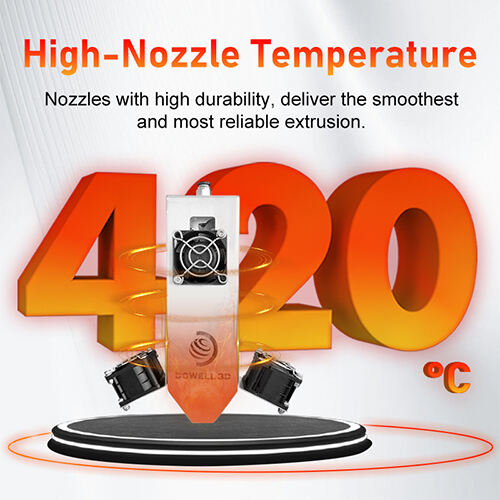Существует удивительный потенциал использования нескольких материалов 3D-печать , рассмотрите гибкие шарниры в жестких объектах, постепенные переходы цвета для достижения определённого внешнего вида или функциональности, детали с функциональным градиентом. Однако температура сопла — это наиболее важный параметр, который необходимо точно контролировать для обеспечения бесшовной интеграции различных пластиков. Это не просто плавление филамента, это дирижирование симфонией различных материалов в вашей печати.
Необходимость точки плавления
Температура сопла должна точно соответствовать тепловым требованиям всех материалов, которые экструдируются. Каждый тип полимера имеет свой диапазон температуры плавления или температуры стеклования. При переходе с PLA (~200-220 °C) на PETG (~250-230 °C) требуется значительное изменение температуры. Слишком низкая температура не позволит новому материалу расплавиться, что вызовет засоры, недостаточную экструзию и плохое сцепление слоев. Слишком высокая температура приведет к деградации, обугливанию или потере структурной целостности уже существующего материала (в сопле или вблизи области печати). Точное температурное управление по материалу не является делом выбора.
Клей, который связывает: Сцепление между слоями
За процессом отдельного плавления происходит магия на стыке материалов. Хорошее сцепление различных слоев и материалов имеет первостепенное значение для прочности и функциональности детали. Главная роль здесь отводится температуре сопла. При нанесении нового слоя его расплав должен быть достаточно горячим, чтобы расплавить поверхность предыдущего слоя, обеспечивая молекулярное переплетение на границе материалов. Эти переплавы недостаточны в каждом случае, когда температура на границе ниже требуемой для любого из материалов, что приводит к слабому сцеплению и визуально заметным слоистым линиям, а также склонности деталей к расслаиванию под нагрузкой. Важно найти идеальную температуру, которая усиливает сплавление, не нарушая свойства каждого из материалов.
Укрощение теплового чудовища: коробление и напряжение
При многослойной печати разными материалами часто возникают ситуации, когда пластики с сильно различающимися коэффициентами теплового расширения и характеристиками охлаждения взаимодействуют друг с другом. ABS сжимается намного больше при охлаждении по сравнению с PLA, у которого низкое сжатие. Когда материал с высокой усадкой наносится на затвердевший слой материала с низкой усадкой, на границе между ними возникают огромные силы внутреннего напряжения, поскольку усадка у них разная. Это часто проявляется в виде коробления, растрескивания или полного отслоения под границей материалов. С этим можно бороться с помощью стратегического контроля температуры сопла. В некоторых случаях, если температура материала с высокой усадкой немного снижена, пиковая сила сжатия также уменьшается. В более альтернативном решении можно воспользоваться тем, что нижележащий слой остаётся немного тёплым (но не расплавленным) в момент нанесения нового материала, что позволяет обеспечить более плавный тепловой переход и помочь уменьшить концентрацию напряжений.
Достижение баланса
Контроль температуры сопла во время печати несколькими материалами — это работа по поддержанию динамического равновесия. Это требует знания соответствующих тепловых профилей всех задействованных нитей, а также их взаимодействия. Существует несколько стратегических моментов, включая:
1. Точные профили материалов: Точные настройки и калибровка оптимальной температуры всех нитей, которые сохранены.
2. Динамическое переключение: Обеспечение быстрой и точной смены материалов, поскольку принтер может точно достигать целевой температуры.
3. Оптимизация интерфейса: Некоторое варьирование температур (незначительное понижение и повышение) на переходных слоях между материалами для максимального сцепления.
4. Учет охлаждения: Соотношение температуры сопла и скорости вентилятора охлаждения детали для контроля скорости затвердевания и уменьшения деформационных напряжений.
Ключевой проводник
Существует набор параметров, которым должен следовать каждый для реализации печати несколькими материалами: высота слоя, скорость, обратная подача, но самым важным является температура сопла. Она определяет, насколько правильно материалы расплавляются и соединяются, а также как они взаимодействуют друг с другом без разрушительных внутренних усилий. Обращая внимание на различные тепловые требования отдельных нитей и на то, как они взаимодействуют на границах, вы выведете контроль температуры сопла из простого параметра, который нужно установить, на уровень ключевого компонента, способного сделать реальностью сложные, действительно полезные и полностью интегрированные конструкции из нескольких материалов. Уделите время, чтобы изучить и понять это — ваши отпечатки станут лучше и стабильнее.

 EN
EN
 AR
AR
 BG
BG
 HR
HR
 DA
DA
 NL
NL
 FR
FR
 DE
DE
 EL
EL
 HI
HI
 IT
IT
 JA
JA
 KO
KO
 PT
PT
 RU
RU
 ES
ES
 SV
SV
 TL
TL
 ID
ID
 SR
SR
 SK
SK
 UK
UK
 VI
VI
 ET
ET
 HU
HU
 TH
TH
 TR
TR
 MS
MS
 GA
GA
 BE
BE
 HY
HY
 KA
KA
 LO
LO
 LA
LA
 MN
MN
 NE
NE
 SO
SO
 MY
MY
 KK
KK
 UZ
UZ
